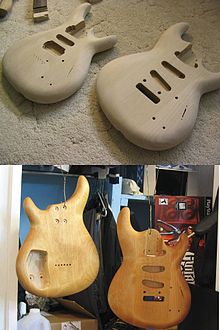- Tung oil
-
Major fatty acid composition of tung oil[1] Palmitic acid 5.5% Oleic acid 4.0% Linoleic acid 8.5% alpha-Eleostearic acid 82.0% Tung oil or China wood oil is a drying oil obtained by pressing the seed from the nut of the tung tree (Vernicia fordii). As a drying oil, tung oil hardens (dries) upon exposure to air. The resulting coating is transparent plastic-like and is exploited in most of its applications, which include wood finishing and the composition of oil paints and printing inks. Related drying oils include linseed, safflower, poppy, and soybean.[2] The oil and its use are believed to have originated in ancient China, and appear in the writings of Confucius from about 400 B.C. Raw Tung oil tends to dry with a fine wrinkled finish, the US name for this is Gas Checking, this property is used to make Crystal finishes. To stop this, the oil is heated to gas proof it and most oils used for coating are gas-proofed. This property was used to make wrinkle finishes, usually by adding excess cobalt drier.
The name is often used by paint and varnish as a generic name for any wood finishing product that contains the real tung oil and/or provides a finish that resembles that obtained with it.[3]
Contents
Uses
Wood finishing
When applied in many fine coats over wood, tung oil slowly cures to a satin "wetted wood" look with slight golden tint. It resists liquid water better than any other pure oil finish, though it still provides little protection against water vapor exchange or scratches. Tung oil does not darken noticeably with age and is claimed to be less susceptible to mold than linseed oil.[4]
Tung oil has become popular as an environmentally friendly wood finish, but it should be noted that many products labelled as "tung oil finishes" are deceptively labelled: polymerized oils, wiping varnishes, and oil/varnish blends have all been known to be sold as tung oil finishes (sometimes containing no tung oil at all), and all the above contain solvents and/or chemical driers.[5] Product packaging will usually clearly state if it is pure tung oil, so there is a good chance you will be buying something else if the sales literature is vague.
Heating tung oil to about 500 degrees in an oxygen-free environment will substantially increase the viscosity and film-forming quality of the product. The resulting polymerized tung oil will range in consistency from that of maple syrup to that of motor oil. Most polymerized tung oils are sold mixed with mineral spirits to make them easier to work with. Limonene and D-limonene are less toxic alternatives for the mineral spirits.
Application
The traditional technique for applying pure tung oil is to dilute the oil 1:1 with solvent, then apply a succession of very thin films with a soft non-fuzzy cloth such as tee-shirt cotton. Dilutants range from traditional spirits of turpentine to any of the new citrus-based thinners to naphtha. The choice of thinner should be guided by how fast the coating needs to set. Naphtha works well in spray-on applications in well ventilated studios. Primary coats may be laid down at a 1:1 oil-to-thinner ratio, and successive layers, if not absorbed into the wood, at higher solvent to oil concentrations. This technique brings out the deepest color of the wood while maintaining a matte finish.
Tung oil finishes that start with polymerized oils or tung oil preparations are best applied in the fat over lean principle: thinned pure oil is applied to deeply penetrate the surface, to fill pores. Straight oil is then applied moderately to adhere to the surface and provide a good base for the thick gloss layers. The polymerized oil is then applied thickly as a single layer, allowed to fully dry, is buffed smooth with very fine sandpaper, then 00 steel wool. The surface is wiped clean with a moistened rag, then allowed to dry. A final coat is applied fairly thickly (the oil will smooth itself into a glass-like coating) and allowed to dry for two to three days. The resulting finish is almost completely impervious to water.[citation needed]
Food contact and allergic reactions
As the source of tung oil is a nut, people with nut allergies often report adverse reactions to contact with (or even the odour of) tung oil. Reactions can be severe in some cases. While tung oil has been used for many centuries as a finish for kitchen items such as wooden bowls and cutting boards, some individuals must avoid its use.
Other uses
As the penetrating power of tung oil is excellent and it will adhere to porous minerals, it is often used by stonemasons on granite or marble installed in kitchens, bathrooms, and other staining fluid environments. Applied at a 1:5 ratio (oil to naphtha), it seals the surfaces permanently[citation needed], while also giving a finish like that of wet stone to the product. Often several thin layers are applied at the high solvent-to-oil ratio, in order to build up the durability and permanence of the coating. The non-yellowing nature of tung oil is vitally important for its satisfactory use in these applications.
References
- ^ Food and Agriculture Organization of the United Nations. "Minor oil crops - Individual monographs". http://www.fao.org/docrep/X5043E/x5043E0e.htm. Retrieved 2007-10-15.
- ^ Ulrich Poth, "Drying Oils and Related Products" in Ullmann's Encyclopedia of Industrial Chemistry Wiley-VCH, Weinheim, 2002. doi:10.1002/14356007.a09_055
- ^ Tung Oil, WoodworkDetails.com
- ^ Flexner, Bob. Understanding Wood Finishing. Reader's Digest Association, Inc, 2005, p. 77.
- ^ Flexner, Bob. Understanding Wood Finishing. Reader's Digest Association, Inc, 2005, p. 71, 79.
External links
Categories:- Painting materials
- Vegetable oils
- Wood finishing materials
Wikimedia Foundation. 2010.

